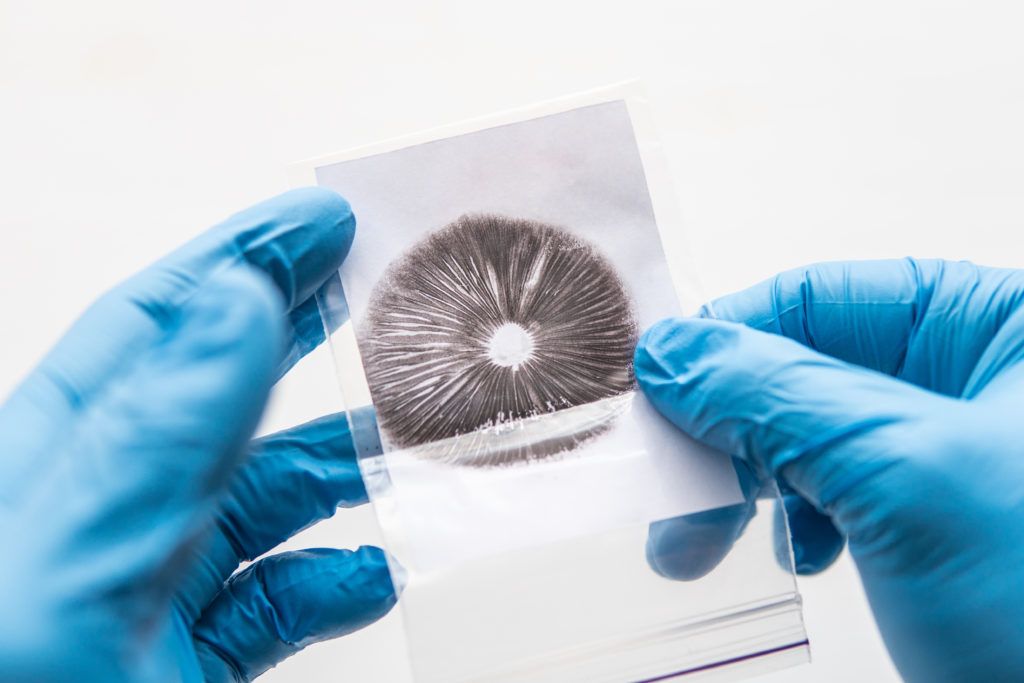
Psilocybin mushrooms (aka magic mushrooms) have a long-standing reputation for turning blue when bruised or undergoing environmental stress. In 2019, scientists led by Dr. Claudius Lenz discovered the chemical mechanism behind the transformation of psilocybin molecules into blue compounds.1 Historically, expert mycologists like Paul Stamets have relied on bluing as one criterion for identifying psilocybin-containing mushrooms in addition to a purple-brown spore print.2
Interestingly, the mycelium of many psilocybin mushrooms such as Psilocybe cubensis also bruises blue, indicating the presence of psilocybin. It is also well known in the psychedelic mushroom cultivation community and law enforcement that the spores of P. cubensis (and other psilocybin-containing mushrooms) don’t contain psilocybin. Hence, the spores are available for purchase but only for microscopy studies. It’s a different story when a person introduces the spores into a favorable environment and mycelium starts growing. The production of psilocybin-containing mycelium (and the subsequent mushroom fruiting) is a violation of the law in many jurisdictions.
This presents an interesting question for mycologists to take on. Why is there no psilocybin in the spores?
When in Doubt, Ask Paul Stamets
In June 2021, psychedelic mushroom expert Paul Stamets was a guest at the Oregon Department of Human Services Psilocybin Advisory Board Product Subcommittee Meeting.3 While discussing potential commercial growing operations of P. cubensis, Stamets said (34:46), “…[the] spores contain no psilocybin, the flesh of the mushroom transmutates into gills into spores.”
Therefore, the statement is suggesting that somewhere along the way between gills and spore formation, psilocybin stops going along for the ride. Psychedelic Science Review reached out to Stamets for further insight on the state of the art in psilocybin and spores.
“Psilocybe cubensis mycelium makes mushrooms which have lots of psilocybin, psilocin, and other analogs. The mushroom flesh is thick at first – rich in psilocybin et alia. The gills are very small and spores have not yet formed in mass” (Paul Stamets, email communication, July 2021).
He continued, “When the flesh transforms and becomes gills, and the flesh thins, and then spores form from the gills. There is a proportionate loss of psilocybin as now the flesh is less massive.
Something happens in the biotransformation of flesh into spores that result in spores being devoid of psilocybin.
So, what exactly is the “something” that happens?
More Research is Needed
Mycologists have some high-level understanding of why magic mushroom spores don’t contain psilocybin. But the real key lies in discovering the enzymatic and other molecular mechanisms that are working behind the scenes. Are the mushrooms conserving their psilocybin stores? Would psilocybin inhibit spore growth? Is there psilocin in the spores?
Lurking in the shadows behind the bright lights of pharmacological testing and clinical trials, some basic understanding of the sources of natural psychedelic compounds like psilocybin remains a mystery.

Great article, thank you for writing and sharing it.Q: Do you inow if cubensis mycelium contains psilocybin? Thanx again.